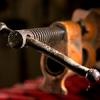I often hear people say that they want to join as soon as possible after dimensioning. The idea being to get it together before the wood has a chance to move. I've heard this from novices and experts alike. I do exactly the opposite, so I wonder what's really right.
I'm curious what others here do and especially why. Maybe I'll learn something new.
Here's how I approach milling and joining wood. I expect wood to move as it is cut and re-cut.
When cut from the tree the slabs bow, twist and cup as internal stress is relieved and the piece moves over time into equilibrium. This might take hours, days or weeks. As it dries, new stress may be created and eventually balanced through other movement. Once it's dried and and cut into thinner, narrower and shorter pieces, there is once again a high likelihood the wood will move. Sometimes by looking at the grain I can guess how it will move when cut. Other times I can't even guess until It's cut. The wood may move immediately as it's cut or it may move slowly over days and weeks. Sometimes both. Changes in ambient moisture typically have a little affect on well dried wood, IMO. I have stock that's been sitting stable for many years despite huge swings in seasonal humidity. The wood does move but doesn't seem to bow, cup or twist in response to moisture.
That's my basic working understanding of common wood movement. Right or wrong, that's what I base my strategy on. With that in mind, I plan for the movement. I cut a little wider and thicker than I need so I have room to remove bows and cups. Whenever possible, I try to remove wood evenly from either side of the stock. I believe this helps to keep the internal stress in balance and minimizes movement. Neither works every time. I just think it improves my odds for getting flat stable pieces from stock at hand. Whenever possible, I use a two step process. I roughly mill the stock slightly oversize. 1/16" - 1/8" thicker and 1/8" - 1/4" wider than I need. Then I let it sit for a week or longer if I can. Right off the saw, I may leave even more room for error as a 1/4" deflection in a 2' long board as it's cut is not uncommon. Personally, I think it's much more common with todays fast growing stock versus the old slow growing stock of the past but that's really just a guess.
For a recent set of small table tops, I milled the pieces up about a month in advance. 2 of the 6 (quarter sawn) pieces moved enough that I could see the bow. I re-jointed and re-planed taking about 1/32" off each side and a few days later did the glue up. So far, the tops are perfectly flat and seem stable.
1) Expect the wood to move when cut but it may not move all at once. Time is your friend.
2) Flatten early, flatten twice, leave the stock larger initially to compensate.
3) Reduce size equally from each side when possible. Plan for more wood movement otherwise.
4) Moisture (for well dried stock) in not a major cause of bowing or cupping. However, it will cause movement across the width and (a little) across the thickness.
That's my $0.02. What do you do?





 Reply With Quote
Reply With Quote

